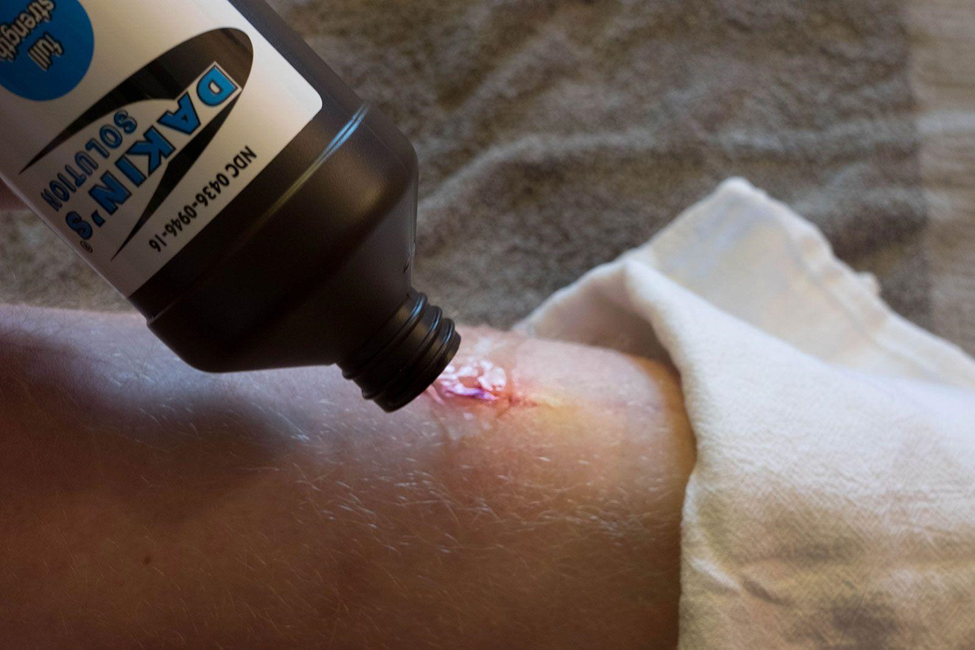Which type of wound debridement is Dakin’s solution used for?
Autolytic debridement
Sharp debridement
Enzymatic debridement
Chemical debridement
The Correct Answer is D
Choice A:
es and moisture to digest necrotic tissue. While Dakin's solution can support this process by maintaining a moist wound environment, it does not directly cause autolytic debridement.
Choice B:
Sharp debridement involves the use of a scalpel, scissors, or other sharp instrument to remove dead tissue. Dakin's solution does not perform this function.
Choice C:
Enzymatic debridement involves the use of a topical application of enzymes to break down necrotic tissue. Dakin's solution does not contain these enzymes.
Choice D:
This is the correct choice. Dakin's solution, a sodium hypochlorite-based solution, is used for chemical debridement¹. It can be used to irrigate the wound bed or as the solution for wet-to-moist dressing, effectively cleansing away wound debris and helping create the ideal environment for healing.

Nursing Test Bank
Naxlex Comprehensive Predictor Exams
Related Questions
Correct Answer is A
Explanation
Choice A rationale
Vacuum-assisted closure (VAC) therapy aids in wound healing primarily by applying negative pressure to draw the wound edges together. This not only helps reduce the size of the wound but also promotes blood flow to the area, which can accelerate healing.
Choice B rationale
While VAC therapy does support the underlying structures of the wound, its primary function is not to strengthen the wall of the wound. The negative pressure assists in removing excess fluid and reducing edema, which indirectly supports the wound structure.
Choice C rationale
VAC therapy does have an impact on bacterial levels within the wound by helping to remove infectious materials. However, its main purpose is not to interrupt bacteria proliferation; this is more directly achieved through antibiotic therapy and proper wound care techniques.
Choice D rationale
While VAC does create a cover over the wound, its main purpose is to apply negative pressure to the wound area. This negative pressure helps to draw the wound edges together, promotes the removal of exudate and potentially infectious material, and stimulates the growth of new tissue, which aids in the healing process12. The occlusive cover is part of the system that allows the negative pressure to be maintained, but it is the negative pressure itself, not the cover, that provides the therapeutic benefit.
Correct Answer is A
Explanation
Choice A rationale
The High-Fowler’s position, with the client sitting upright at a 90-degree angle, is ideal for abdominal wound irrigation as it reduces the risk of fluid accumulation in the wound area and promotes drainage.
Choice B rationale
The side-lying position is not typically used for abdominal wound irrigation because it can cause pooling of the irrigation solution and does not facilitate easy access to the wound site.
Choice C rationale
The supine position, with the client lying flat on their back, is not suitable for abdominal wound irrigation as it can lead to fluid retention in the wound and does not aid in drainage.
Choice D rationale
The dorsal recumbent position, with the client lying on their back with knees bent, is also not optimal for abdominal wound irrigation due to the potential for fluid to collect in the wound area.
Whether you are a student looking to ace your exams or a practicing nurse seeking to enhance your expertise , our nursing education contents will empower you with the confidence and competence to make a difference in the lives of patients and become a respected leader in the healthcare field.
Visit Naxlex, invest in your future and unlock endless possibilities with our unparalleled nursing education contents today
Report Wrong Answer on the Current Question
Do you disagree with the answer? If yes, what is your expected answer? Explain.
Kindly be descriptive with the issue you are facing.
